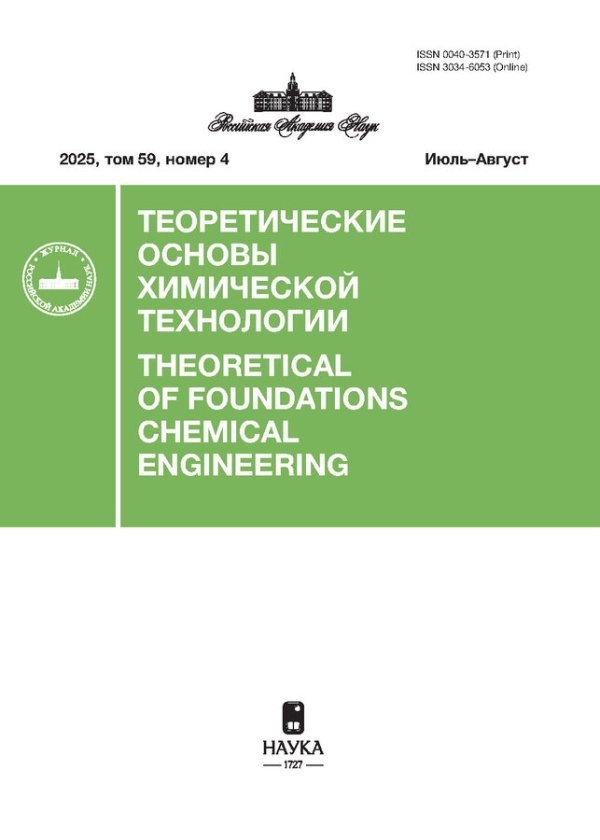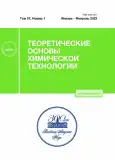Mathematical Modeling of Processes of Separation by Liquid–Liquid Chromatography Methods
- Authors: Kostanyan A.E.1, Voshkin A.A.1
-
Affiliations:
- Kurnakov Institute of General and Inorganic Chemistry, Russian Academy of Sciences
- Issue: Vol 57, No 1 (2023)
- Pages: 3-15
- Section: Articles
- Published: 01.01.2023
- URL: https://journals.rcsi.science/0040-3571/article/view/138392
- DOI: https://doi.org/10.31857/S0040357123010098
- EDN: https://elibrary.ru/BOSZPG
- ID: 138392
Cite item
Full Text
Abstract
The practical implementation of new highly efficient methods of liquid–liquid chromatography requires preliminary mathematical modeling for the conditions of the separation process being developed, including its equipment design. In this work, two approaches to the mathematical description of the processes of liquid–liquid chromatography are theoretically analyzed, one of which is based on solving the material-balance equations of a model of a cascade of equilibrium steps, and the other of which uses the Gaussian distribution to describe the outlet concentration profiles of the components of the mixture being separated. It is shown that, if the number of equilibrium steps (characterizing the efficiency of the chromatographic system) is N ≥ 50, then the separation processes can be mathematically modeled using the simpler dependences obtained from the Gaussian distribution. For the conditions when the efficiency of the chromatographic system is N < 50, dependences are obtained using the model of equilibrium steps for mathematical modeling of the processes of separation by various methods of liquid–liquid chromatography.
About the authors
A. E. Kostanyan
Kurnakov Institute of General and Inorganic Chemistry, Russian Academy of Sciences
Email: kost@igic.ras.ru
119071, Moscow, Russia
A. A. Voshkin
Kurnakov Institute of General and Inorganic Chemistry, Russian Academy of Sciences
Author for correspondence.
Email: kost@igic.ras.ru
119071, Moscow, Russia
References
- Федотов П. С., Марютина Т.А., Пичугин А.А., Спиваков Б.Я. Влияние кинетических свойств экстракционных систем на разделение некоторых элементов методом жидкостной хроматографии со свободной неподвижной фазой // Журн. неорг. химии. 1993. Т. 38. № 11. С. 1878.
- Марютина Т.А., Федотов П.С., Спиваков Б.Я. Использование метода жидкостной хроматографии со свободной неподвижной фазой для концентрирования и разделения неорганических веществ. Двухфазные жидкостные системы // Журн. аналит. химии. 1997. Т. 52. № 12. С. 1263.
- Berthod A., Maryutina T., Spivakov B., Shpigun O., Sutherland I.A. Countercurrent chromatography in analytical chemistry (IUPAC technical report) // PureAppl. Chem. 2009. V. 81. P. 355.
- Костанян А.Е., Милевский Н.А., Вошкин А.А. Анализ процессов экстракционно-хроматографического разделения в каскаде смесительно-отстойных экстракторов // Теорет. основы хим. технологии. 2021. Т. 55. № 5. С. 559.
- Костанян А.Е., Иванов В.К., Вошкин А.А. Теоретический анализ периодических процессов экстракционно-хроматографического разделения в замкнутом каскаде аппаратов // ДАН. Химия, науки о материалах. 2021. Т. 499. № 1. С. 53.
- Kostanyan A.E., Voshkin A.A. Closed-loop recycling dual-mode counter-current chromatography with specified sample loading durations: Modeling of preparative and industrial-scale separations // Molecules. 2021. V. 26. Article 6561.
- Guilois-Dubois S., Guyot S., Poupard P. Preparative isolation of apple flavan-3-ols monomers and oligomers using pH-zone-refining centrifugal partition chromatography combined with reversed-phase liquid chromatography // J. Chromatogr. A. 2021. V. 1653. Article 462382.
- Li H., Zhang F., Jin Q., Zhu T. Preparative separation and purification of Cyclosporin D from fungus Hypoxylon Spp. by improved closed-loop recycling counter-current chromatography // J. Chromatogr. A. 2021. V. 1649. Article 462221.
- He J.M., Huang J., Wu W.L., Mu Q. Unlimited recycling counter-current chromatography for the preparative separation of natural products: naph- thaquinones as examples // J. Chromatogr. A. 2020. V. 1626. Article 461368.
- Kostanyan A., Martynova M. Modeling of two semi-continuous methods in liquid–liquid chromatography: Comparing conventional and closed-loop recycling modes // J. Chromatogr. A. 2020. V. 1614. Article 460735.
- Kostanyan A.E., Belova V.V. Theoretical study of industrial scale closed-loop recycling counter-current chromatography separations // J. Chromatogr. A. 2020. V. 1633. Article 461630.
- Kostanyan A.E., Galieva Z.N., Semenov A.A., Aldushkin A.V. Chromatographic behavior of six lanthanides on a centrifugal mixer-settler extractor cascade. // J. Chromatogr. A. 2020. V. 1634. Article 461686.
- Kostanyan A.A., Voshkin A.A., Belova V.V. Analytical, Preparative, and Industrial-Scale Separation of Substances by Methods of Countercurrent Liquid-Liquid Chromatography // Molecules. 2020. V. 25. Article 6020.
- Jerz G., Winterhalter P. The 10th International Conference on Countercurrent Chromatography held at Technische Universität Braunschweig, Braunschweig, Germany, August 1–3, 2018 // J. Chromatogr. A. 2020. V. 1617. Article 460698.
- Morley R., Minceva M. Operating mode and parameter selection in liquid–liquid chromatography // J. Chromatogr. A. 2020. V. 1617. Article 460479.
- Kostanya, A.E., Belova V.V. Closed-loop recycling dual-mode counter-current chromatography. A theoretical study // J. Chromatogr. A. 2019. V. 1588. P. 174.
- Kostanyan A.E., Galieva Z.N. Modeling of closed-loop recycling dual-mode counter-current chromatography based on non-ideal recycling model // J. Chromatogr. A. 2019. V. 1603. P. 240.
- Roehrer S., Minceva M. Evaluation of interapparatus separation method transferability in countercurrent chromatography and centrifugal partition chromatography // Separations. 2019. V. 6. P. 36.
- Peng A., Hewitson P., Sutherland I., Chen L., Ignatova S. How changes in column geometry and packing ratio can increase sample load and throughput by a factor of fifty in counter-current chromatography // J. Chromatogr. A. 2018. V. 1580. P.120.
- Friesen J.B., McAlpine J.B., Chen S.-N., Pauli G.F. The 9th International Countercurrent Chromatography Conference held at Dominican University, Chicago, USA, August 1–3, 2016 // J. Chromatogr. A. 2017. V. 1520. P. 1.
- Ito Y. Golden rules and pitfalls in selecting optimum conditions for high-speed counter-current chromatography // J. Chromatogr. A. 2005. V. 1065. P. 145.
- Conway W.D. Counter-current chromatography: Simple process and confusing terminology // J. Chromatogr. A. 2011. V. 1218. P. 6015.
- Friesen J.B., McAlpine J.B., Chen S.-N., Pauli G.F. The 9th International Countercurrent Chromatography Conference held at Dominican University, Chicago, USA, August 1–3, 2016. // J. Chromatogr. A 2017. V. 1520. P. 1.
- Ignatova S., Sutherland I. The 8th International Conference on Counter-current Chromatography held at Brunel University, London, UK, July 23–25, 2014 // J. Chromatography A. 2015. V. 1425. P. 1.
- Kostanyan A.E., Voshkin A.A. Analysis of cyclic liquid chromatography // Theor. Found. Chem. Eng. 2011. V. 45. № 1. P. 68.
- Kostanyan A.E., Voshkin A.A. Support-free pulsed liquid-liquid chromatography // J. Chromatogr. A. 2009. V. 1216. P. 7761.
- Kostanyan A.E., Voshkin A.A., Kodin N.V. Controlled-cycle pulsed liquid–liquid chromatography. A modified version of Craig’s counter-current distribution // J. Chromatogr. A. 2011. V. 1218. P. 6135.
- Kostanyan A.E. A simple and highly efficient counter-current chromatography method for the isolation of concentrated fractions of compounds based on the sequential sample loading technique: Comparative theoretical study of conventional multiple and intermittent sample loading counter-current chromatography separations // J. Chromatogr. A. 2021. V. 1647. Article 462163.
- Kostanyan A.E. Simple equations to simulate closed-loop recycling liquid–liquid chromatography: ideal and non-ideal recycling models // J. Chromatogr. A. 2015. V. 1423. P. 71.
Supplementary files


















